
The animals are out engaging with visitors regardless of the weather. Spring is a particularly exciting time at the animal display as many baby animals are born. Come and see our keepers interact with and feed the babies. Meet the newborns and watch them grow up!
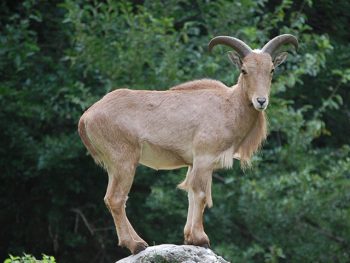
Barbary sheep, also known as Aoudad, come from North Africa and are the only sheep native to Africa. Their habitat is rough, rocky and barren waterless areas. They eat grasses, plants, and bushes. Within their range water is scarce, so they get enough water through eating green vegetation and the dew which condenses on leaves during the night. Males and females both have horns. The Rams (males) have long hair on the neck, front legs, and chest.
These sheep are very agile and can jump over 2 metres from a stand-still. They love to wallow in water and mud and will use their horns to throw mud up on their back. It helps to keep them cool and keeps flies and parasites away. They are more active in the morning and the evening, resting during the day.
The gestation period for Barbary sheep is 5 months, and twins are common. The lambs learn to jump and climb soon after birth. Their lifespan is 15 years.
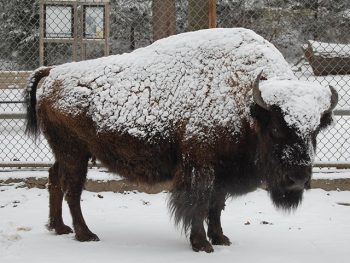
Bison are the largest land mammal in North America. They eat grasses, other plants and drink gallons of water every day. Their habitat is prairies, great plains, and open forests.
An adult can weigh from 900 to 2,000 lbs (410 – 900 kg). Bison like to wallow in dust bowls to escape from flies. They can run at speeds up to 65 km per hour and distinguish smells up to 3 km away.
In the 1800s there were approximately 60 million bison in North America. The arrival of European settlers changed these numbers drastically. During the late 1800s commercial hide hunters, settlers, and thrill-seekers shot millions of bison, leaving less than 1000 bison alive by 1900. Conservation over the last 100 years has brought the numbers back up to more than 350,000 animals.
Though often referred to as American buffalo, bison are not buffalo. When the first settlers came to America and saw bison, they did not know what they were. The only animals they could relate to were the Asian Water Buffalo. As a result, they called them buffalo and the name stuck for many years.
The gestation period for bison is 9 months and calves generally weigh between 40 – 50 lbs (18 – 23 kg). Their lifespan is 25 years.
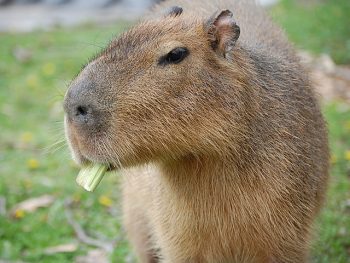
The capybara is the world’s largest rodent. It originates from South America, where it lives in densely vegetated areas around ponds, lakes, rivers, and other bodies of water. This is a herd animal that prefers to live in large groups of 20 or more.
Capybaras spend most of their life in water. They mate in the water, use water to escape predators (such as anacondas, pumas, caimans, jaguars and humans), and can stay submerged for several minutes. They love to swim and have partially webbed toes. With small eyes located close to the top of the head, the capybara can see and breathe at the water’s surface without exposing itself to potential predators.
Capybara can weigh up to 140 lbs (73 kg). Their diet consists of vegetation such as river plants, grass and bark. They like to vocalize or make sounds that include low clicking sounds, whistles, and barks. Male capybaras have a scent gland on their nose that they use to mark their territory.
The gestation period for capybara is about 5 months. The average litter size is 5 babies. Their lifespan is 10 years.
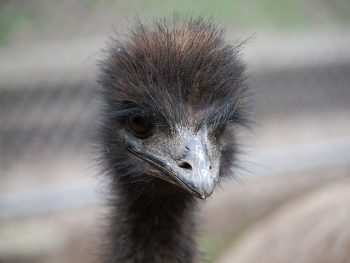
Emus are the second-largest flightless birds in the world, next to the ostrich. They originate from Australia. Emus have tiny wings and cannot fly, but their legs are long and very powerful. They can travel long distances quickly and reach speeds of up to 50 km per hour. They also have great eyesight and hearing.
Their calls consist of loud booming, drumming and grunting sounds that can be heard up to two kilometres away. In the wild, they eat a variety of native and introduced plant species, flowers, seeds and insects. They are curious birds known to follow and watch other animals and humans.
A female emu lays an average of 11 very large, thick-shelled, dark-green eggs (that are equivalent to about 10–12 chicken eggs in volume and weight). Once the female has laid the eggs the male incubates them for up to 56 days. During this time he does not eat, drinks only occasionally and stands only to turn the eggs, which he does about 10 times a day. Over eight weeks of incubation, he will lose a third of his weight and survive only on stored body fat.
The male stays with the growing chicks for up to 18 months, defending them and teaching them how to find food.
In the wild, emus have a lifespan of 10 to 20 years. In captivity, they can live even longer.
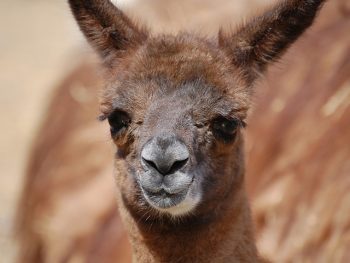
Llamas are members of the camel family. They come in many different patterns and colours including black, brown, white and all shades in between. Native to the Andes Mountains in South America, llamas are built for high altitudes, cold weather and are very sure-footed.
Llamas were domesticated by the Incas around 4000 BC. The Incas referred to llamas as “silent brother”. Highly regarded and even worshipped, they were used for their wool, meat and to carry goods over the mountains. They are willing pack-animals but have limits and an overloaded llama will simply refuse to move. These animals often lie down and may spit, hiss, or even kick at their owners until their burden is lessened. Typically, they are saddled with loads of 50 to 75 pounds (23 – 34 kg). Pack trains of llamas, which can include several hundred animals, move large amounts of goods over the very rough terrain of the Andes.
Llamas have excellent eyesight and are sometimes used today as a guard animal for small livestock like sheep. They are very curious and clever animals and communicate with hums, grunts and a variety of ear, body and tail postures. Llamas will spit when they are angry, scared and to establish dominance.
The gestation period for llamas is 11.5 months. At birth, a baby llama (called a cria) weighs between 9 and 14 kg (20 – 30 lb). Their lifespan is 20 years.
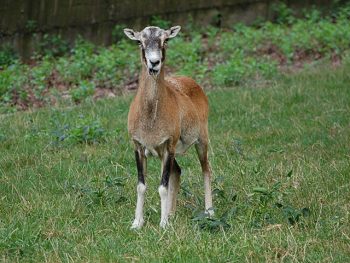
The mouflon is thought to be one of the two ancestors for all modern sheep breeds. They are found in Corsica and Sardinia, Cyprus and have been introduced into many parts of Europe. Like most wild sheep, mouflon live in mountainous terrain, usually above the tree line or in mountain meadows.
A mouflon weighs between 55 and 120 lbs (25 – 55 kg). They have a rough coat, and during the winter grow a woolly undercoat that keeps them warm. Generally, only the males have horns, however, some females may have small horns also. Males and females usually live in separate groups and come together only during mating season. The mouflon is a shy animal that feeds mostly at night. These sheep also feed intermittently throughout the day, resting during the hottest hours. They are extremely fast runners.
The gestation period for mouflon sheep is 5 months and twins are common. Their lifespan is 15 to 20 years.
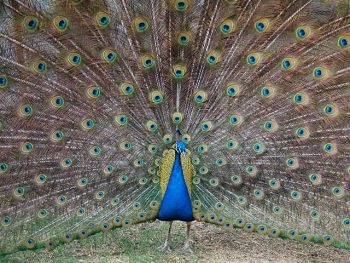
These birds are large and colourful pheasants. Technically, males are peacocks, females are peahens and together they are called peafowl. They are forest birds that nest on the ground but prefer to roost in trees, flying up onto the branches. Peafowl are native to India and Sri Lanka, and the peacock is the national bird of India.
Males have a bright blue neck and a large feather train. The train grows from the back, not the tail. It can take 3 years for the male to develop the train, which is used in mating rituals and courtship displays. It can be arched into a magnificent fan that reaches across the bird’s back and touches the ground on either side. Females are believed to choose their mates according to the size, colour, and quality of these feather trains. At the end of summer, the birds moult, losing their feathers until they grow back by Christmas.
Peahens usually lay 4 to 6 eggs and incubate them for 28 days. Baby peafowl are called peachicks. Their lifespan is 20 years.
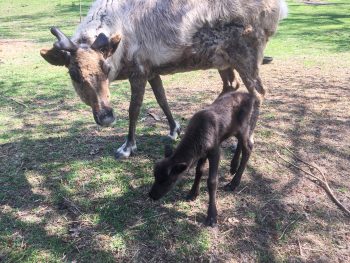
In Canada and Alaska wild reindeer are called caribou, while in Europe and Asia they are called reindeer. Reindeer are a member of the deer family. There are seven subspecies of reindeer. They live in the arctic tundra of North America, Northern Europe and Asia. Reindeer eat grass, lichens and plants and migrate to follow their food supply.
Reindeer have several great adaptations that help them live in the cold and snow. They have large, curved hooves that act as snowshoes in winter. Reindeer are excellent swimmers, in part because their hooves act as paddles when they swim. Reindeer also have large, furry noses to warm the cold air before it gets to their lungs and a very dense, double-layered fur coat to protect them from the coldest weather.
Both male and female reindeer have antlers. The bulls (males) lose their antlers in late fall/early winter. Females lose theirs in the late spring after they have had their calves.
The gestation period for reindeer is 7.5 months. Their lifespan is 10-20 years.
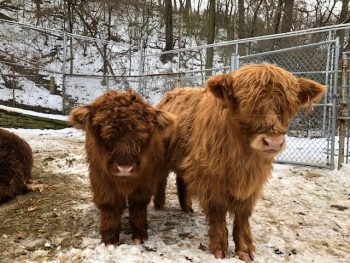
These cows are an old breed of domestic beef cattle developed in the Highlands of Scotland. Highlanders were the earliest registered breed of cattle. They come from two sets of stock, one originally black and the other reddish. Highlands have a double coat of hair – a downy undercoat and a long outer coat. Their long fringe of hair shields the eyes against snow and driving rain and helps prevent eye infections spread by insects. Because of their double coat, they do not put on a thick layer of fat for warmth like many other animals do. This makes their meat lean (low in fat).
Highlands are even-tempered, docile and intelligent cows. They are also unusually healthy and hardy. Unlike many other popular breeds of cattle, they survive and even thrive on roughage (plant material that is high in fibre but low in energy), poor grazing and under harsh weather conditions.
A group of Highland Cattle is called a fold (as opposed to a herd). The Queen of England has a fold of Highland cattle at Balmoral Castle in Scotland.
The gestation period for West Highland cattle is 9.5 months. Highland cattle are typically a long-lived breed. Their lifespan can be more than 20 years.
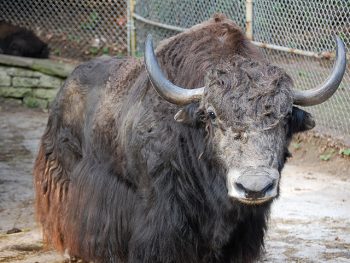
The yak is a distinctive shaggy, hoofed mammal living in the Himalayas. It roams the mountains of Nepal, Tibet, parts of China and as far north as Mongolia. The domestic yak is very vocal, making frequent grunts. The yak can weigh up to 2000 lbs (907 kg).
The yak is well adapted to harsh mountains with its thick coat, great lung capacity and ability to move skilfully over rough terrain. Yaks are designed to live at high altitudes and have small blood cells, as well as three times more red blood cells than cows, which lets their blood can carry more oxygen. They are sure-footed climbers and can easily tolerate temperatures of – 40 °C.
Wild yak herds travel on snow in single file, carefully stepping on footprints left by the lead yak. Domestic yaks are used to pull loads and plough fields. They are also combed for their fur, which is spun and woven into various fibre products. Yak milk is popular in southern China and Tibet.
The gestation period for yak is 9 months. Their lifespan is 20 years.
The animal display is a popular destination for schools, camps and seniors’ groups from across the city. People who come with a registered tour have the opportunity to participate in a Meet the Keeper session and get a behind-the-scenes tour.
For more information on tours, email Friends of High Park Zoo.
High Park Animal Display is Canada’s oldest animal display, originally housing a deer pen and an aviary. The animal display was established in 1893 following John and Jemima Howard’s gift of their home, Colborne Lodge, and its 165-acre grounds to the City of Toronto for use as a public park. Other land was later added to make High Park what it is today. Over 600,000 visitors come to the animal display every year.
Friends of High Park Zoo (FHPZ) is a non-profit group working with the City of Toronto to undertake a Master Plan of capital improvements to preserve and enhance the animal attraction at High Park. Support these initiatives by donating to FHPZ.
Please do not feed the animals as they are on supervised diets.